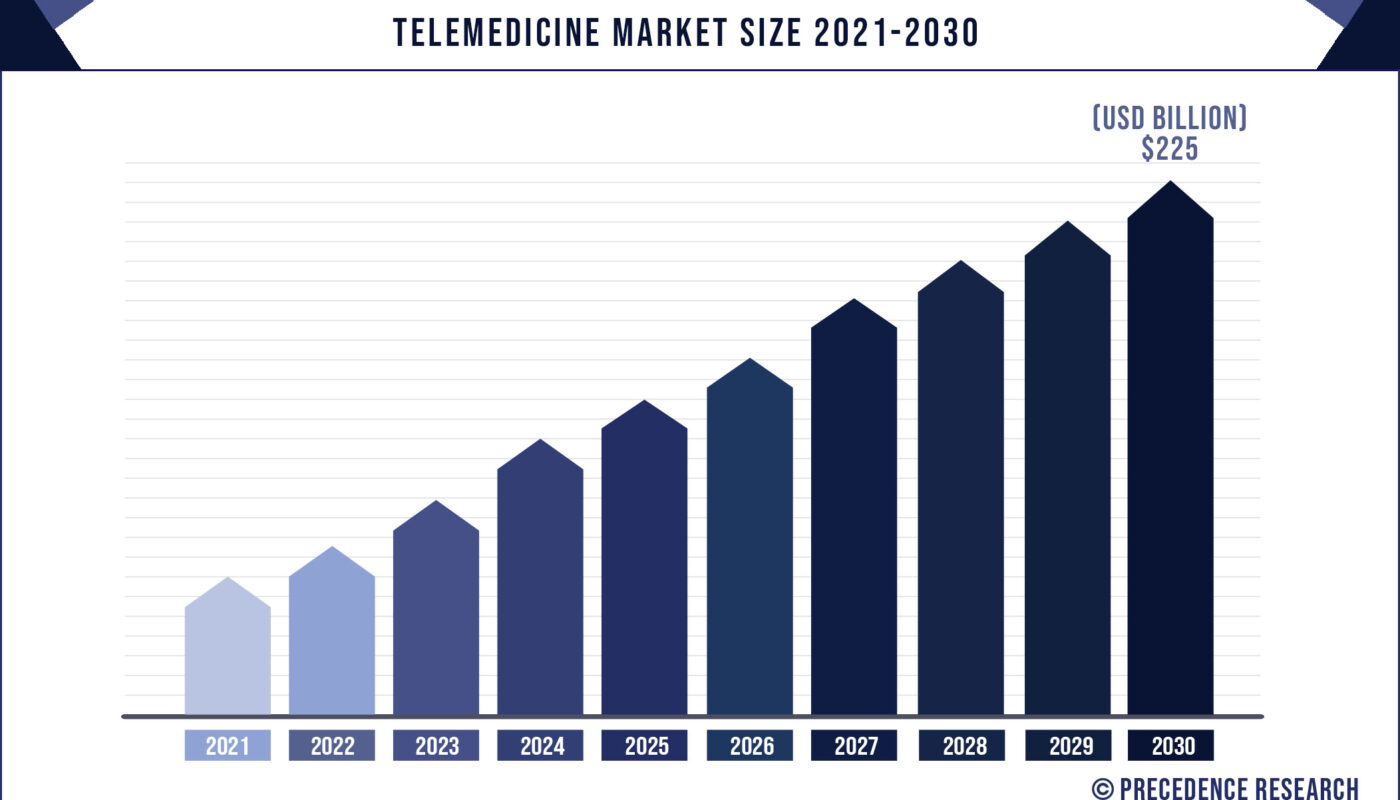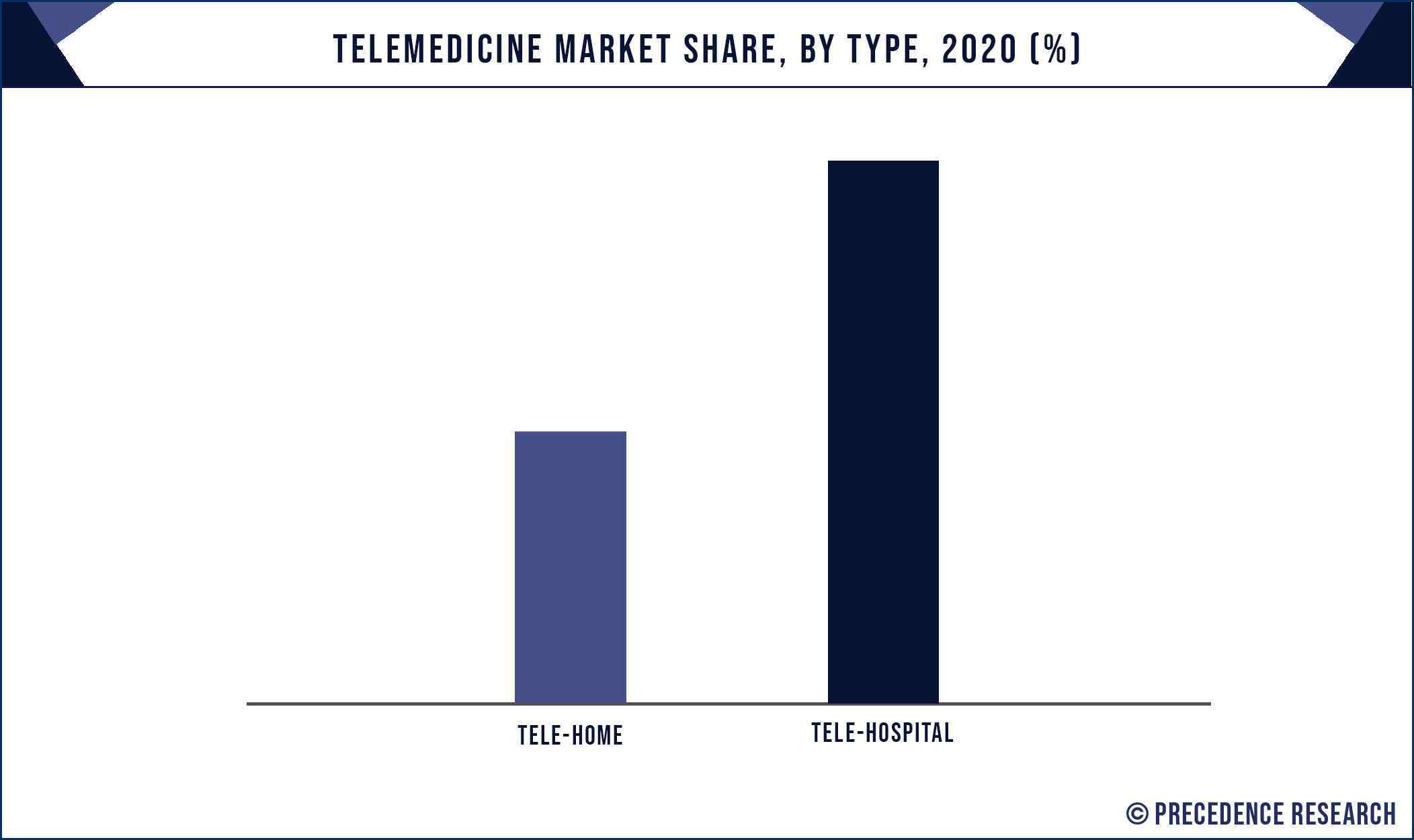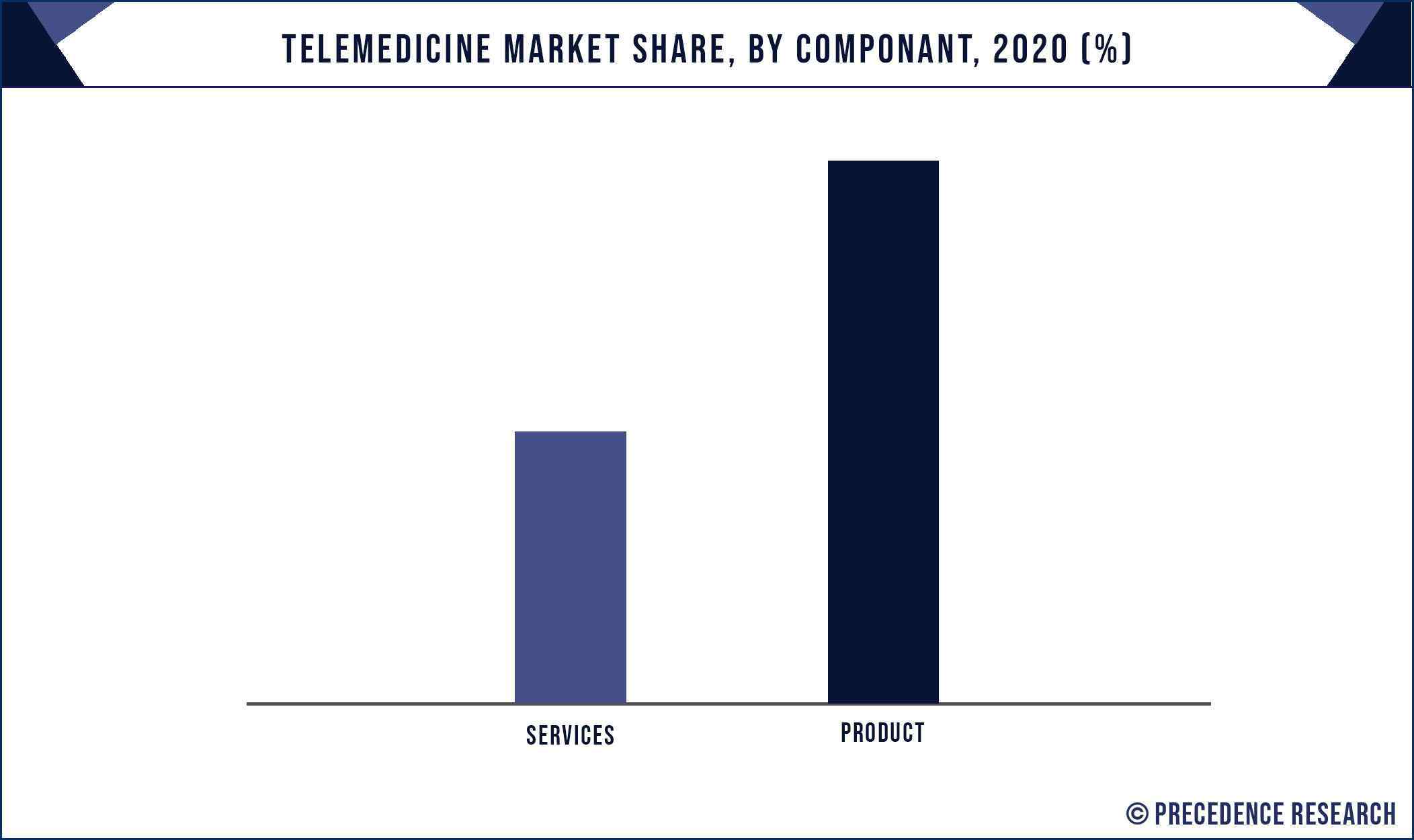According to the industry experts, The telemedicine market size is projected to reach around US$ 225 billion by 2030 from USD 53 billion in 2021 growing at a CAGR of 15.6% from 2021 to 2030. The report contains 150+ pages with detailed analysis.
The base year for the study has been considered 2021, the historic year 2019 and 2020, the forecast period considered is from 2021 to 2030. The telemedicine market is analyzed on the basis of value (US$ Million), volume (Unit), and price (US$/Unit).
The global telemedicine market growth is driven by the increasing investments on the development of IT infrastructure, development of strong telecommunication channels, rising penetration of internet, increasing adoption of smartphones, and growing popularity of the digital technology.
According to a data published by the ITU, approximately 4 billion people are internet users, by the end of 2019. Further, the telemedicine market is exponentially driven by the rising prevalence of chronic diseases and growing geriatric population. The telemedicine provides easy and convenient healthcare services to the users, at a lower cost, from the comfort of their homes. The rapid adoption of the digital technologies among the healthcare industry and the population is fueling the growth of the global telemedicine market. The increased adoption of telemedicine among the users is significantly driving the adoption of the telemedicine platform among the physicians and doctors, and hence this is contributing towards the market growth.
The telemedicine gained immense traction among the population owing to the outbreak of the COVID-19 and the measures adopted by the government to contain the spread of the virus. The lockdown situation necessitated the use of digital technologies in majority of the industries. The telemedicine emerged an essential platform during the lockdown situation that helped to get consultation from doctors through online medium. This digital mode of healthcare became more effective with the gradual research and development activities.
North America was the dominant telemedicine market in 2020. The improved healthcare infrastructure, strong IT and telecommunications sector, and increased awareness among the population regarding the telehealth is the major factor that boosted the growth of the market. Moreover, increases prevalence of diseases and growing geriatric population in the nation like US is significantly contributing towards the development of the telemedicine market.
Asia Pacific is expected to be the fastest-growing market during the forecast period. This can be attributed to the rising adoption of digital technologies in the healthcare sector, rapidly developing telecommunications and IT infrastructure in the region. Moreover, rapidly growing adoption of internet ad smartphones is positively impacting the market growth in this region.
Cyberattacks and data breach are the major threats to the telemedicine market as it operates using digital platform. The increased risks associated with the data breach and cyberattacks that may lead to huge financial losses may hamper the growth of the market during the forecast period.
The introduction of the latest technologies such as artificial intelligence and 5G are expected to provide new growth prospects to the market players in the foreseeable future. The rising investments in the development and adoption of 5G may change the face of the telemedicine market in the future.
Lack of awareness regarding the telemedicine owing to the no access to the internet and smartphones. The underdeveloped nations have poor IT infrastructure that remains the major challenge for the market players. Moreover, low disposable income results in lower adoption of internet and smartphones.
Based on the type, the tele-home segment is expected to be the fastest-growing segment during the forecast period. The rising awareness regarding the hospital acquired infections among the population may restrict the patient to opt for hospital. Moreover, many old-age patients require at-home treatment and continuous monitoring that is expected to foster the growth of the overall market.
Based on component, the products segment dominated the market in 2020.The product segment includes software and hardware. The hardware consists of wide variety of devices such as keyboards, monitors, communication lines, and various other devices. The extensive use of wide variety of costly hardware devices have significantly contributed towards the growth of this segment. Moreover, increasing investments on the acquisition of advanced hardware in the hospitals for improving the patient care services is positively impacting the segment growth.
Based on application, the telecardiology segment is expected to be the fastest-growing segment during the forecast period. This can be attributed to the rising prevalence of cardiovascular diseases among the population. Moreover, the telemedicine technology can offer continuous patient monitoring feature that may drive the demand for this segment in the upcoming years.
Based on the technology, the store & forward segment dominated the market in 2020. The store and forward technology stores the medical history of the patients and can provide useful information to the doctors at the time of treatment that can offer improve patient care. This feature solely drives the demand for this technology owing to the increasing needs for the regular monitoring of the patients’ health.
Download the Sample Pages of this Report for Better Understanding (Including TOC, List of Tables & Figures, and Chart) @ https://www.precedenceresearch.com/sample/1366
Telemedicine Marekt Key Players/Manufacturers
This report also provides detailed company profiles of the key market players. This research report also highlights the competitive landscape of the telemedicine market and ranks noticeable companies as per their occurrence in diverse regions across the globe and crucial developments initiated by them in the market space. This research study also tracks and evaluates competitive developments, such as collaborations, partnerships, and agreements, mergers and acquisitions; novel product introductions and developments, promotion strategies and Research and Development (R&D) activities in the marketplace. The competitive profiling of these players includes business and financial overview, gross margin, production, sales, and recent developments which can aid in assessing competition in the market.
Some of the prominent players in the global telemedicine market include:
- Koninklijke Philips N.V.
- Medtronic
- GE Healthcare
- Cerner Corporation
- Siemens Healthineers
- Cisco Systems, Inc.
- Teladoc Health Inc.
- American Well
- AMC Health
- MDLive
Read Also: Material Handling Equipment Market Size to Reach US$ 46+ Billion By 2030
Telemedicine Market Segments Covered
By Type
- Tele-hospital
- Tele-Home
By Component
- Product
- Hardware
- Software
- Others
- Services
- Tele-consulting
- Tele-monitoring
- Tele-education
By Application
- Telepathology
- Teleradiology
- Teledermatology
- Telepsychiatry
- Telecardiology
- Others
By Technology
- Store & Forward
- Real-Time
- Others
By Delivery Mode
- Web/Mobile
- Telephonic
- Visualized
- Call Centers
By Geography
- North America
- U.S.
- Canada
- Europe
- U.K.
- Germany
- France
- Asia Pacific
- China
- India
- Japan
- South Korea
- Rest of the World
Research Objective
- To provide a comprehensive analysis of the telemedicine industry and its sub-segments in the global market, thereby providing a detailed structure of the industry
- To provide detailed insights into factors driving and restraining the growth of this global market
- To provide a distribution chain analysis/value chain for the this market
- To estimate the market size of the global telemedicine market where 2019 would be the historical period, 2020 shall be the base year, and 2020 to 2027 will be the forecast period for the study
- To provide strategic profiling of key companies (manufacturers and distributors) present across the globe, and comprehensively analyze their competitiveness/competitive landscape in this market
- To analyze the global market in four main geographies, namely, North America, Europe, Asia-Pacific, and the Rest of the World
- To provide country-wise market value analysis for various segments of the telemedicine
TABLE OF CONTENT
Chapter 1. Introduction
1.1. Research Objective
1.2. Scope of the Study
1.3. Definition
Chapter 2. Research Methodology
2.1. Research Approach
2.2. Data Sources
2.3. Assumptions & Limitations
Chapter 3. Executive Summary
3.1. Market Snapshot
Chapter 4. Market Variables and Scope
4.1. Introduction
4.2. Market Classification and Scope
4.3. Industry Value Chain Analysis
4.3.1. Raw Material Procurement Analysis
4.3.2. Sales and Distribution Channel Analysis
4.3.3. Downstream Buyer Analysis
Chapter 5. COVID 19 Impact on Telemedicine Market
5.1. COVID-19 Landscape: Telemedicine Industry Impact
5.2. COVID 19 – Impact Assessment for the Industry
5.3. COVID 19 Impact: Global Major Government Policy
5.4. Market Trends and Opportunities in the COVID-19 Landscape
Chapter 6. Market Dynamics Analysis and Trends
6.1. Market Dynamics
6.1.1. Market Drivers
6.1.2. Market Restraints
6.1.3. Market Opportunities
6.2. Porter’s Five Forces Analysis
6.2.1. Bargaining power of suppliers
6.2.2. Bargaining power of buyers
6.2.3. Threat of substitute
6.2.4. Threat of new entrants
6.2.5. Degree of competition
Chapter 7. Competitive Landscape
7.1.1. Company Market Share/Positioning Analysis
7.1.2. Key Strategies Adopted by Players
7.1.3. Vendor Landscape
7.1.3.1. List of Suppliers
7.1.3.2. List of Buyers
Chapter 8. Global Telemedicine Market, By Type
8.1. Telemedicine Market, by Type, 2021-2030
8.1.1. Tele-hospital
8.1.1.1. Market Revenue and Forecast (2019-2030)
8.1.2. Tele-Home
8.1.2.1. Market Revenue and Forecast (2019-2030)
Chapter 9. Global Telemedicine Market, By Application Type
9.1. Telemedicine Market, by Application Type, 2021-2030
9.1.1. Telepathology
9.1.1.1. Market Revenue and Forecast (2019-2030)
9.1.2. Teleradiology
9.1.2.1. Market Revenue and Forecast (2019-2030)
9.1.3. Teledermatology
9.1.3.1. Market Revenue and Forecast (2019-2030)
9.1.4. Telepsychiatry
9.1.4.1. Market Revenue and Forecast (2019-2030)
9.1.5. Telecardiology
9.1.5.1. Market Revenue and Forecast (2019-2030)
9.1.6. Others
9.1.6.1. Market Revenue and Forecast (2019-2030)
Chapter 10. Global Telemedicine Market, By Technology Type
10.1. Telemedicine Market, by Technology Type, 2021-2030
10.1.1. Store & Forward
10.1.1.1. Market Revenue and Forecast (2019-2030)
10.1.2. Real-Time
10.1.2.1. Market Revenue and Forecast (2019-2030)
10.1.3. Others
10.1.3.1. Market Revenue and Forecast (2019-2030)
Chapter 11. Global Telemedicine Market, By Delivery Mode Type
11.1. Telemedicine Market, by Delivery Mode Type, 2021-2030
11.1.1. Web/Mobile (Telephonic, Visualized)
11.1.1.1. Market Revenue and Forecast (2019-2030)
11.1.2. Call Centers
11.1.2.1. Market Revenue and Forecast (2019-2030)
Chapter 12. Global Telemedicine Market, By Component Type
12.1. Telemedicine Market, by Component, 2021-2030
12.1.1. Product (Hardware, Software, Others)
12.1.1.1. Market Revenue and Forecast (2019-2030)
12.1.2. Services (Tele-consulting, Tele-monitoring, Tele-education)
12.1.2.1. Market Revenue and Forecast (2019-2030)
Chapter 13. Global Telemedicine Market, Regional Estimates and Trend Forecast
13.1. North America
13.1.1. Market Revenue and Forecast, by Type (2019-2030)
13.1.2. Market Revenue and Forecast, by Application (2019-2030)
13.1.3. Market Revenue and Forecast, by Technology (2019-2030)
13.1.4. Market Revenue and Forecast, by Delivery Mode (2019-2030)
13.1.5. Market Revenue and Forecast, by Component (2019-2030)
13.1.6. U.S.
13.1.6.1. Market Revenue and Forecast, by Type (2019-2030)
13.1.6.2. Market Revenue and Forecast, by Application (2019-2030)
13.1.6.3. Market Revenue and Forecast, by Technology (2019-2030)
13.1.6.4. Market Revenue and Forecast, by Delivery Mode (2019-2030)
13.1.7. Market Revenue and Forecast, by Component (2019-2030)
13.1.8. Rest of North America
13.1.8.1. Market Revenue and Forecast, by Type (2019-2030)
13.1.8.2. Market Revenue and Forecast, by Application (2019-2030)
13.1.8.3. Market Revenue and Forecast, by Technology (2019-2030)
13.1.8.4. Market Revenue and Forecast, by Delivery Mode (2019-2030)
13.1.8.5. Market Revenue and Forecast, by Component (2019-2030)
13.2. Europe
13.2.1. Market Revenue and Forecast, by Type (2019-2030)
13.2.2. Market Revenue and Forecast, by Application (2019-2030)
13.2.3. Market Revenue and Forecast, by Technology (2019-2030)
13.2.4. Market Revenue and Forecast, by Delivery Mode (2019-2030)
13.2.5. Market Revenue and Forecast, by Component (2019-2030)
13.2.6. UK
13.2.6.1. Market Revenue and Forecast, by Type (2019-2030)
13.2.6.2. Market Revenue and Forecast, by Application (2019-2030)
13.2.6.3. Market Revenue and Forecast, by Technology (2019-2030)
13.2.7. Market Revenue and Forecast, by Delivery Mode (2019-2030)
13.2.8. Market Revenue and Forecast, by Component (2019-2030)
13.2.9. Germany
13.2.9.1. Market Revenue and Forecast, by Type (2019-2030)
13.2.9.2. Market Revenue and Forecast, by Application (2019-2030)
13.2.9.3. Market Revenue and Forecast, by Technology (2019-2030)
13.2.10. Market Revenue and Forecast, by Delivery Mode (2019-2030)
13.2.11. Market Revenue and Forecast, by Component (2019-2030)
13.2.12. France
13.2.12.1. Market Revenue and Forecast, by Type (2019-2030)
13.2.12.2. Market Revenue and Forecast, by Application (2019-2030)
13.2.12.3. Market Revenue and Forecast, by Technology (2019-2030)
13.2.12.4. Market Revenue and Forecast, by Delivery Mode (2019-2030)
13.2.13. Market Revenue and Forecast, by Component (2019-2030)
13.2.14. Rest of Europe
13.2.14.1. Market Revenue and Forecast, by Type (2019-2030)
13.2.14.2. Market Revenue and Forecast, by Application (2019-2030)
13.2.14.3. Market Revenue and Forecast, by Technology (2019-2030)
13.2.14.4. Market Revenue and Forecast, by Delivery Mode (2019-2030)
13.2.15. Market Revenue and Forecast, by Component (2019-2030)
13.3. APAC
13.3.1. Market Revenue and Forecast, by Type (2019-2030)
13.3.2. Market Revenue and Forecast, by Application (2019-2030)
13.3.3. Market Revenue and Forecast, by Technology (2019-2030)
13.3.4. Market Revenue and Forecast, by Delivery Mode (2019-2030)
13.3.5. Market Revenue and Forecast, by Component (2019-2030)
13.3.6. India
13.3.6.1. Market Revenue and Forecast, by Type (2019-2030)
13.3.6.2. Market Revenue and Forecast, by Application (2019-2030)
13.3.6.3. Market Revenue and Forecast, by Technology (2019-2030)
13.3.6.4. Market Revenue and Forecast, by Delivery Mode (2019-2030)
13.3.7. Market Revenue and Forecast, by Component (2019-2030)
13.3.8. China
13.3.8.1. Market Revenue and Forecast, by Type (2019-2030)
13.3.8.2. Market Revenue and Forecast, by Application (2019-2030)
13.3.8.3. Market Revenue and Forecast, by Technology (2019-2030)
13.3.8.4. Market Revenue and Forecast, by Delivery Mode (2019-2030)
13.3.9. Market Revenue and Forecast, by Component (2019-2030)
13.3.10. Japan
13.3.10.1. Market Revenue and Forecast, by Type (2019-2030)
13.3.10.2. Market Revenue and Forecast, by Application (2019-2030)
13.3.10.3. Market Revenue and Forecast, by Technology (2019-2030)
13.3.10.4. Market Revenue and Forecast, by Delivery Mode (2019-2030)
13.3.10.5. Market Revenue and Forecast, by Component (2019-2030)
13.3.11. Rest of APAC
13.3.11.1. Market Revenue and Forecast, by Type (2019-2030)
13.3.11.2. Market Revenue and Forecast, by Application (2019-2030)
13.3.11.3. Market Revenue and Forecast, by Technology (2019-2030)
13.3.11.4. Market Revenue and Forecast, by Delivery Mode (2019-2030)
13.3.11.5. Market Revenue and Forecast, by Component (2019-2030)
13.4. MEA
13.4.1. Market Revenue and Forecast, by Type (2019-2030)
13.4.2. Market Revenue and Forecast, by Application (2019-2030)
13.4.3. Market Revenue and Forecast, by Technology (2019-2030)
13.4.4. Market Revenue and Forecast, by Delivery Mode (2019-2030)
13.4.5. Market Revenue and Forecast, by Component (2019-2030)
13.4.6. GCC
13.4.6.1. Market Revenue and Forecast, by Type (2019-2030)
13.4.6.2. Market Revenue and Forecast, by Application (2019-2030)
13.4.6.3. Market Revenue and Forecast, by Technology (2019-2030)
13.4.6.4. Market Revenue and Forecast, by Delivery Mode (2019-2030)
13.4.7. Market Revenue and Forecast, by Component (2019-2030)
13.4.8. North Africa
13.4.8.1. Market Revenue and Forecast, by Type (2019-2030)
13.4.8.2. Market Revenue and Forecast, by Application (2019-2030)
13.4.8.3. Market Revenue and Forecast, by Technology (2019-2030)
13.4.8.4. Market Revenue and Forecast, by Delivery Mode (2019-2030)
13.4.9. Market Revenue and Forecast, by Component (2019-2030)
13.4.10. South Africa
13.4.10.1. Market Revenue and Forecast, by Type (2019-2030)
13.4.10.2. Market Revenue and Forecast, by Application (2019-2030)
13.4.10.3. Market Revenue and Forecast, by Technology (2019-2030)
13.4.10.4. Market Revenue and Forecast, by Delivery Mode (2019-2030)
13.4.10.5. Market Revenue and Forecast, by Component (2019-2030)
13.4.11. Rest of MEA
13.4.11.1. Market Revenue and Forecast, by Type (2019-2030)
13.4.11.2. Market Revenue and Forecast, by Application (2019-2030)
13.4.11.3. Market Revenue and Forecast, by Technology (2019-2030)
13.4.11.4. Market Revenue and Forecast, by Delivery Mode (2019-2030)
13.4.11.5. Market Revenue and Forecast, by Component (2019-2030)
13.5. Latin America
13.5.1. Market Revenue and Forecast, by Type (2019-2030)
13.5.2. Market Revenue and Forecast, by Application (2019-2030)
13.5.3. Market Revenue and Forecast, by Technology (2019-2030)
13.5.4. Market Revenue and Forecast, by Delivery Mode (2019-2030)
13.5.5. Market Revenue and Forecast, by Component (2019-2030)
13.5.6. Brazil
13.5.6.1. Market Revenue and Forecast, by Type (2019-2030)
13.5.6.2. Market Revenue and Forecast, by Application (2019-2030)
13.5.6.3. Market Revenue and Forecast, by Technology (2019-2030)
13.5.6.4. Market Revenue and Forecast, by Delivery Mode (2019-2030)
13.5.7. Market Revenue and Forecast, by Component (2019-2030)
13.5.8. Rest of LATAM
13.5.8.1. Market Revenue and Forecast, by Type (2019-2030)
13.5.8.2. Market Revenue and Forecast, by Application (2019-2030)
13.5.8.3. Market Revenue and Forecast, by Technology (2019-2030)
13.5.8.4. Market Revenue and Forecast, by Delivery Mode (2019-2030)
13.5.8.5. Market Revenue and Forecast, by Component (2019-2030)
Chapter 14. Company Profiles
14.1. Koninklijke Philips N.V.
14.1.1. Company Overview
14.1.2. Product Offerings
14.1.3. Financial Performance
14.1.4. Recent Initiatives
14.2. Medtronic
14.2.1. Company Overview
14.2.2. Product Offerings
14.2.3. Financial Performance
14.2.4. Recent Initiatives
14.3. GE Healthcare
14.3.1. Company Overview
14.3.2. Product Offerings
14.3.3. Financial Performance
14.3.4. Recent Initiatives
14.4. Cerner Corporation
14.4.1. Company Overview
14.4.2. Product Offerings
14.4.3. Financial Performance
14.4.4. Recent Initiatives
14.5. Siemens Healthineers
14.5.1. Company Overview
14.5.2. Product Offerings
14.5.3. Financial Performance
14.5.4. Recent Initiatives
14.6. Cisco Systems, Inc.
14.6.1. Company Overview
14.6.2. Product Offerings
14.6.3. Financial Performance
14.6.4. Recent Initiatives
14.7. Teladoc Health Inc.
14.7.1. Company Overview
14.7.2. Product Offerings
14.7.3. Financial Performance
14.7.4. Recent Initiatives
14.8. American Well
14.8.1. Company Overview
14.8.2. Product Offerings
14.8.3. Financial Performance
14.8.4. Recent Initiatives
14.9. AMC Health
14.9.1. Company Overview
14.9.2. Product Offerings
14.9.3. Financial Performance
14.9.4. Recent Initiatives
14.10. MDLive
14.10.1. Company Overview
14.10.2. Product Offerings
14.10.3. Financial Performance
14.10.4. Recent Initiatives
Chapter 15. Research Methodology
15.1. Primary Research
15.2. Secondary Research
15.3. Assumptions
Chapter 16. Appendix
16.1. About Us
16.2. Glossary of Terms
Thanks for reading you can also get individual chapter-wise sections or region-wise report versions such as North America, Europe, or the Asia Pacific.
Why Buy this Report?
The purpose of Precedence Research’s telemedicine market study is to provide stakeholders with a detailed picture of potential barriers and untapped opportunities. The report contains exclusive information to assist businesses in making informed decisions about how to maintain growth throughout the assessment period.
Buy Full Research Report (Single User License US$ 4500) @ https://www.precedenceresearch.com/checkout/1366
Contact Us:
Mr. Alex
Sales Manager
Call: +1 9197 992 333
Email: sales@precedenceresearch.com
Web: https://www.precedenceresearch.com



